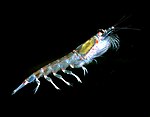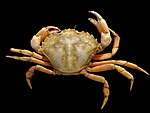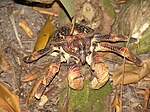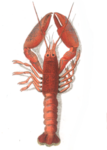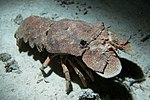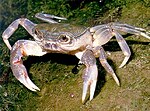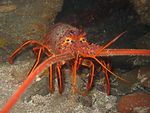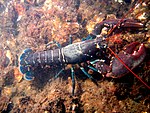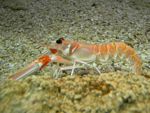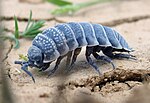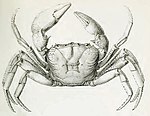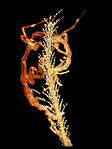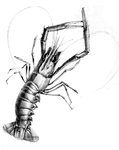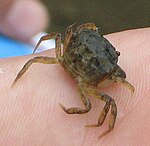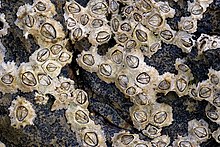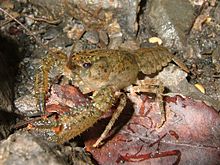Selected articles
Portal:Crustaceans/Selected article/1
Antarctic krill, Euphausia superba, is a species of krill found in the Antarctic waters of the Southern Ocean. Antarctic krill are shrimp-like invertebrates or crustaceans that live in large schools, called swarms, sometimes reaching densities of 10,000–30,000 individual animals per cubic metre. They feed directly on minute phytoplankton, thereby using the primary production energy that the phytoplankton originally derived from the sun in order to sustain their pelagic (open ocean) life cycle. They grow to a length of 6 cm (2.4 in), weigh up to 2 g (0.07 oz), and can live for up to six years. They are a key species in the Antarctic ecosystem and are, in terms of biomass, probably the most successful animal species on the planet, with a combined mass of approximately 500 million tonnes.Portal:Crustaceans/Selected article/2
Carcinus maenas, the shore crab or green crab, is a common littoral crab, and an important invasive species, listed among the 100 "world's worst alien invasive species". Although native to the Baltic Sea, North Sea and north-east Atlantic Ocean, it has since become established on both east and west coasts of North America, in Argentina, South Africa and Australia. C. maenas is a predator feeding on many organisms, particularly bivalve molluscs (such as clams, oysters, and mussels), polychaetes and small crustaceans. It is primarily nocturnal, although activity also depends on the tide, and crabs can be active at any time of day.Portal:Crustaceans/Selected article/3
The coconut crab, Birgus latro, is a species of terrestrial hermit crab, also known as the "robber crab" or "palm thief". It is the largest land-living arthropod in the world, and is probably at the upper size limit of terrestrial animals with exoskeletons in today's atmosphere at a weight of up to 4.1 kg (9.0 lb). It is found on islands across the Indian Ocean and parts of the Pacific Ocean as far east as the Gambier Islands, mirroring the distribution of the coconut palm. Adults develop a tough exoskeleton on their abdomen and stop carrying a shell. They cannot swim, and will drown if immersed in water for long. Sexual maturity is reached after about 5 years, and the total lifespan may be over 60 years.Adult coconut crabs feed on fruits, nuts, seeds, and the pith of fallen trees, but will eat carrion and other organic matter opportunistically. The species is popularly associated with the coconut, and has been widely reported to climb trees to pick coconuts, which it then opens to eat the flesh. While coconut crabs can climb trees, and can eventually open a coconut collectively, coconuts are not a significant part of their diet. Coconut crabs are hunted wherever they come into contact with humans, and are subject to legal protection in some areas. In the absence of precise information, the IUCN lists the species as Data Deficient.
Portal:Crustaceans/Selected article/4
The Cape lobster, Homarinus capensis, is a species of small lobster that lives off the coast of South Africa, from Dassen Island to Haga Haga. Only a few dozen specimens are known, mostly regurgitated by reef-dwelling fish. It lives in rocky reefs, and is thought to lay large eggs that have a short larval phase, or that hatch directly as a juvenile. The species grows to a total length of 10 cm (3.9 in), and resembles a small European or American lobster; it was previously included in the same genus, Homarus, although it is not very closely related to those species, and is now considered to form a separate, monotypic genus – Homarinus. Its closest relatives are the genera Thymops and Thymopides.Portal:Crustaceans/Selected article/5
Krill is a shrimp-like marine invertebrate animal. These small crustaceans are important organisms of the zooplankton, particularly as food for baleen whales, manta rays, whale sharks, crabeater seals, other seals, and a few seabird species that feed almost exclusively on them. Krill occur in all oceans of the world. They are considered an important trophic connection – near the bottom of the food chain – because they feed on phytoplankton and to a lesser extent zooplankton, converting these into a form suitable for many larger animals for whom krill makes up the largest part of their diet. In the Southern Ocean, one species, the Antarctic krill, Euphausia superba, makes up an estimated biomass of over 500 million tonnes, roughly twice that of humans. Of this, over half is eaten by whales, seals, penguins, squid and fish each year, and is replaced by growth and reproduction. Most krill species display large daily vertical migrations, thus providing food for predators near the surface at night and in deeper waters during the day.Portal:Crustaceans/Selected article/6
Scyllarides latus, the Mediterranean slipper lobster, is a species of slipper lobster found in the Mediterranean Sea and in the eastern Atlantic Ocean. It is edible and highly regarded as food, but is now rare over much of its range due to overfishing. Adults may grow to 1 foot (30 cm) long, are camouflaged, and have no claws. They are nocturnal, emerging from caves and other shelters during the night to feed on molluscs. As well as being eaten by humans, S. latus is also preyed upon by a variety of bony fish. Its closest relative is S. herklotsii, which occurs off the Atlantic coast of West Africa; other species of Scyllarides occur in the western Atlantic Ocean and the Indo-Pacific. The larvae and young animals are largely unknown.Portal:Crustaceans/Selected article/7
Potamon fluviatile is a freshwater crab found in or near wooded streams, rivers and lakes in Southern Europe. It is an omnivore with broad ecological tolerances, and adults typically reach 50 mm (2 in) in size during their 10–12 year lifespan. They inhabit burrows and are aggressive, apparently outcompeting native crayfish. P. fluviatile has been harvested for food since Classical antiquity, and is now threatened by overexploitation. Many of the island populations are particularly vulnerable, and the Maltese subspecies has become a conservation icon. A population in Rome is the only population of freshwater crabs to occur in the middle of a large city, and may have been brought there before the founding of the Roman Empire.Portal:Crustaceans/Selected article/8
The California spiny lobster, Panulirus interruptus, is a species of spiny lobster found in the eastern Pacific Ocean from Monterey Bay, California to the Gulf of Tehuantepec, Mexico. It typically grows to a length of 30 cm (12 in) and is a reddish-brown color with stripes along the legs, and has a pair of enlarged antennae but no claws. The interrupted grooves across the tail are characteristic for the species.Females can carry up to 680,000 eggs, which hatch after 10 weeks into flat phyllosoma larvae. These feed on plankton before the metamorphosis into the juvenile state. Adults are nocturnal and migratory, living among rocks at depths of up to 65 m (213 ft), and feeding on sea urchins, clams, mussels and worms. The spiny lobster is eaten by various fish, octopuses and sea otters, but can defend itself with a loud noise produced by its antennae. The California spiny lobster is the subject of both commercial and recreational fishery in both Mexico and the United States, with sport fishermen using hoop nets and commercial fishermen using lobster traps.
Portal:Crustaceans/Selected article/9
Cancer pagurus, commonly known as the edible crab or brown crab, is a species of crab found in the North Sea, North Atlantic Ocean and perhaps in the Mediterranean Sea. It is a robust crab of a reddish-brown colour, having an oval carapace with a characteristic "pie crust" edge and black tips to the claws. A mature adult may have a carapace width of up to 25 cm (10 in) and weigh up to 3 kg (6.6 lb). C. pagurus is a nocturnal predator, targeting a range of molluscs and crustaceans. It is the subject of the largest crab fishery in Western Europe, centred around the coasts of the British Isles, with more than 60,000 tonnes caught annually.Portal:Crustaceans/Selected article/10
Homarus gammarus, known as the European lobster or common lobster, is a species of clawed lobster from the eastern Atlantic Ocean, Mediterranean Sea and parts of the Black Sea. It is closely related to the American lobster, H. americanus. It may grow to a length of 60 cm (24 in) and a mass of 6 kilograms (13 lb), and bears a conspicuous pair of claws. In life, the lobsters are blue, only becoming "lobster red" on cooking. Mating occurs in the summer, producing eggs which are carried by the females for up to a year before hatching into planktonic larvae. Homarus gammarus is a highly esteemed food, and is widely caught using lobster pots, mostly around the British Isles.Portal:Crustaceans/Selected article/11
Nephrops norvegicus, known variously as the Norway lobster, Dublin Bay prawn, langoustine (compare langostino) or scampi, is a slim, orange-pink lobster which grows up to 25 cm (10 in) long, and is "the most important commercial crustacean in Europe". It is now the only extant species in the genus Nephrops, after several other species were moved to the closely related genus Metanephrops. It lives in the north-eastern Atlantic Ocean, and parts of the Mediterranean Sea, but is absent from the Baltic Sea and Black Sea. Adults emerge from their burrows at night to feed on worms and fish.Portal:Crustaceans/Selected article/12
Chirocephalus diaphanus is a widely distributed European species of fairy shrimp that lives as far north as Great Britain, where it is the only surviving species of fairy shrimp and is protected under the Wildlife and Countryside Act 1981. It is a translucent animal, about 0.5 in (13 mm) long, with reddened tips to the abdomen and appendages. The body comprises a head, a thorax bearing 11 pairs of appendages, and a seven-segmented abdomen. In males, the antennae are enlarged to form "frontal appendages", while females have an egg pouch at the end of the thorax.The life cycle of C. diaphanus is extremely fast, and the species can only persist in pools without predators. The eggs tolerate drying out, and hatch when re-immersed in water. C. diaphanus was first reported in the scientific literature in 1704, but was only separated from other species and given its scientific name in 1803; the specific epithet diaphanus refers to the animal's transparency.
Portal:Crustaceans/Selected article/13
Hemilepistus reaumuri is a species of woodlouse that lives in and around the deserts of North Africa and the Middle East, "the driest habitat conquered by any species of crustacean". It reaches a length of 22 mm (0.87 in) and a width of up to 12 mm (0.47 in), and has seven pairs of legs which hold its body unusually high off the ground. H. reaumuri occurs at great population densities and fills an important niche in the desert ecosystem. It feeds on plant leaves, obtains most of its water from moisture in the air and sand, and is in turn an important prey item for the scorpion Scorpio maurus. H. reaumuri is only able to survive in such arid conditions because it has developed parental care of its offspring. Adults dig burrows which are inhabited by family groups, which are recognised using pheromones. The burrows are 40–50 cm (16–20 in) deep, and the woodlice retreat to the relatively cool and moist conditions of the burrow when surface conditions are unfavourable. The territorial limit of each colony is marked with a faecal embankment.Portal:Crustaceans/Selected article/14
Johngarthia lagostoma is a species of terrestrial crab that lives on Ascension Island and three other islands in the South Atlantic. It grows to a carapace width of 110 mm (4.3 in) on Ascension Island, where it is the largest native land animal. It exists in two distinct colour morphs, one yellow and one purple, with few intermediates. The yellow morph dominates on Ascension Island, while the purple morph is more frequent on Atol das Rocas. The species differs from other Johngarthia species by the form of the third maxilliped.J. lagostoma lives in burrows among vegetation, at altitudes of up to 400 m (1,300 ft), emerging at night to feed on plant matter and occasionally on animals. From January to March there is an annual migration to the sea to release the planktonic larvae. The species was first described (as Gecarcinus lagostoma) by Henri Milne-Edwards in 1837 from material sent to him by the naturalists Jean René Constant Quoy and Joseph Paul Gaimard, collected by the French ship Astrolabe.
Portal:Crustaceans/Selected article/15
Neotrypaea californiensis (formerly Callianassa californiensis), known as the Bay ghost shrimp, is a species of ghost shrimp that lives on the Pacific coast of North America. It is a pale animal which grows to a length of 11.5 cm (4.5 in). One claw is bigger than the other, especially in males, and the enlarged claw is thought to have a function in mating. N. californiensis is a deposit feeder that lives in extensive burrow systems, and is responsible for high rates of bioturbation. It adversely affects oyster farms, and its numbers are controlled in some places by the application of pesticides. It carries out an important role in the ecosystem, and is used by fishermen as bait.Portal:Crustaceans/Selected article/16 Hemigrapsus estellinensis is an extinct species of crab, formerly endemic to the Texas Panhandle. It was closely related to species from the Pacific Ocean such as Hemigrapsus oregonensis, but lived 500 mi (800 km) inland in a hypersaline spring. Its occurrence so far from the ocean has been described as "curious", and it was "probably a Pleistocene relic". It differed from its relatives by the pattern of spots on its back, and by the relative sizes of its limbs. H. estellinensis was discovered by Gordon C. Creel in 1962 and was probably already extinct before his description was published in 1964, after the Estelline Salt Springs where it lived were contained by the United States Army to reduce the salt load on the Prairie Dog Town Fork of the Red River.
Portal:Crustaceans/Selected article/17
Seychellum alluaudi is a species of freshwater crab endemic to the Seychelles, and the only true freshwater crab in that country. It lives in rainforest streams on the archipelago's granitic high islands. Although it may be abundant, little is known about its biology, and it is currently listed as Least Concern on the IUCN Red List. Adults are dark yellow to brown in colour, and have a quadrangular carapace with a width of around 50 mm (2 in). The claws are unequal in size.S. alluaudi was described as a species of Deckenia in 1893 and 1894, and later split off into the monotypic segregate genus Seychellum. Its closest relatives are the two species currently in Deckenia, both of which are found in East Africa. Several hypotheses have been published to explain how Seychellum reached its isolated location; some means of transport across the open ocean is considered the most likely explanation. Seychellum differs from Deckenia in a number of characters, including the lengths of the legs and antennae, and the fact that Deckenia species have flattened legs, compared to those of Seychellum.
Portal:Crustaceans/Selected article/18
Caprella mutica, commonly known as the Japanese skeleton shrimp, is a species of skeleton shrimp. It is a relatively large caprellids, reaching a maximum length of 50 mm (2.0 in). The species is sexually dimorphic, with the males usually being much larger than the females. It is characterised by their "hairy" first and second thoracic segments and the rows of spines on their bodies. Body colour ranges from green to red to blue, depending on the environment. It is an omnivorous, highly adaptable, opportunistic feeder. In turn, it provides a valuable food source for fish, crabs, and other larger predators. C. mutica is usually found in dense colonies attached to submerged man-made structures, floating seaweed, and other organisms.C. mutica is native to shallow protected bodies of water in the Sea of Japan. In as little as 40 years, it has become an invasive species in the North Atlantic, North Pacific, and along the coasts of New Zealand. It is believed to have been accidentally introduced to these areas through the global maritime traffic and aquaculture. Outside of its native range, C. mutica is often exclusively synanthropic, being found in large numbers in and around areas of human activity. Its ecological and economic impact as an invasive species is unknown, but it poses a serious threat to native populations of skeleton shrimp in the affected areas.
Portal:Crustaceans/Selected article/19
Metanephrops challengeri (commonly known as the New Zealand lobster or New Zealand scampi) is a species of slim, pink lobster that lives around the coast of New Zealand. It is typically 13–18 cm (5–7 in) long and weighs around 100 g (3.5 oz). The carapace and abdomen are smooth, and adults are white with pink and brown markings and a conspicuous pair of long, slim claws. M. challengeri lives in burrows at depths of 140–640 m (460–2,100 ft) in a variety of sediments. Although individuals can live for up to 15 years, the species shows low fecundity, where small numbers of larvae hatch at an advanced stage.M. challengeri is a significant prey item for ling, as well as being an important fishery species for human consumption; trawlers catch around 1,000 t (2,200,000 lb) per year under the limitations of New Zealand's Quota Management System. The species was first collected by the Challenger expedition of 1872–1876, but only described as separate from related species by Heinrich Balss in 1914. Although originally classified in the genus Nephrops, it was moved in 1972 to a new genus, Metanephrops, along with most other species then classified in Nephrops.
Portal:Crustaceans/Selected article/20
Dyspanopeus sayi is a species of mud crab that is native to the Atlantic coast of North America. It has also become established outside its native range, living in Swansea Docks since 1960, the Mediterranean Sea since the 1970s, the North Sea since 2007 and the Black Sea since 2010. It can reach a carapace width of 20 mm (0.8 in), and has black tips to its unequal claws. It feeds on bivalves and barnacles, and is in turn eaten by predators including the Atlantic blue crab, Callinectes sapidus. Eggs are produced from spring to autumn, the offspring reach sexual maturity the following summer, and individuals can live for up to two years. The closest relative of D. sayi is D. texanus, which lives in the Gulf of Mexico; the two species differ in subtle features of the genitalia and the last pair of walking legs.Portal:Crustaceans/Selected article/21
Barnacles are arthropods of the subclass Cirripedia in the subphylum Crustacea. They are related to crabs and lobsters, with similar nauplius larvae. Barnacles are exclusively marine invertebrates; many species live in shallow and tidal waters. Some 2,100 species have been described.
Barnacle adults are sessile; most are suspension feeders with hard calcareous shells, but the Rhizocephala are specialized parasites of other crustaceans, with reduced bodies. Barnacles have existed since at least the mid-Carboniferous, some 325 million years ago. (Full article...)
Portal:Crustaceans/Selected article/22

There is a scientific debate which questions whether crustaceans experience pain. It is a complex mental state, with a distinct perceptual quality but also associated with suffering, which is an emotional state. Because of this complexity, the presence of pain in an animal, or another human for that matter, cannot be determined unambiguously using observational methods, but the conclusion that animals experience pain is often inferred on the basis of likely presence of phenomenal consciousness which is deduced from comparative brain physiology as well as physical and behavioural reactions.
Definitions of pain vary, but most involve the ability of the nervous system to detect and reflexively react to harmful stimuli by avoiding it, and the ability to subjectively experience suffering. Suffering cannot be directly measured in other animals. Responses to putatively painful stimuli can be measured, but not the experience itself. To address this problem when assessing the capacity of other species to experience pain, argument by analogy is sometimes used. (yes)
Portal:Crustaceans/Selected article/23

The Japanese spider crab (Macrocheira kaempferi) is a species of marine crab and is the biggest one that lives in the waters around Japan. At around 3.7 meters, it has the largest leg-span of any arthropod. The Japanese name for this species is taka-ashi-gani, (Japanese: タカアシガニ), literally translating to “tall legs crab”. It goes through three main larval stages along with a prezoeal stage to grow to its great size.
The genus Macrocheira contains multiple species. 7,001 fossil species of this genus have been found: M. ginzanensis and M. yabei, both from the Miocene of Japan. Its diverse taxonomic history is an important part of what these creatures are and how they evolved to be what they are today. They are sought by crab fisheries, and are considered a delicacy in Japan. To prevent overexploitation from harming the species, conservation efforts have been put in place to protect them and their population from overfishing. (Full article...)
Portal:Crustaceans/Selected article/24
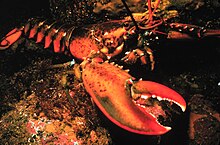
The American lobster (Homarus americanus) is a species of lobster found on the Atlantic coast of North America, chiefly from Labrador to New Jersey. It is also known as Atlantic lobster, Canadian lobster, true lobster, northern lobster, Canadian Reds, or Maine lobster. It can reach a body length of 64 cm (25 in), and a mass of over 20 kilograms (44 lb), making it not only the heaviest crustacean in the world, but also the heaviest of all living arthropod species. Its closest relative is the European lobster Homarus gammarus, which can be distinguished by its coloration and the lack of spines on the underside of the rostrum. American lobsters are usually bluish green to brown with red spines, but several color variations have been observed. (Full article...)
Portal:Crustaceans/Selected article/25
Crayfish are freshwater crustaceans belonging to the infraorder Astacidea, which also contains lobsters. Taxonomically, they are members of the superfamilies Astacoidea and Parastacoidea. They breathe through feather-like gills. Some species are found in brooks and streams, where fresh water is running, while others thrive in swamps, ditches, and paddy fields. Most crayfish cannot tolerate polluted water, although some species, such as Procambarus clarkii, are hardier. Crayfish feed on animals and plants, either living or decomposing, and detritus.
The term "crayfish" is applied to saltwater species in some countries. (Full article...)
